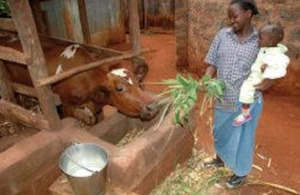DFID Research: Cheap fodder trees help farmers increase milk production
Milk production and income has increased for East African farmers thanks to the introduction of low cost fodder trees

Feeding fresh fodder trees for milk. Picture: World Agroforestry Centre
Introduction of low cost, easy to grow fodder trees, to a quarter of a million farmers across East Africa, for feeding to livestock, has boosted milk yields and incomes, and reduced the need for expensive dairy feed concentrates.
Fodder trees are highly nutritious, easy to grow and, by fixing atmospheric nitrogen, improve soil fertility. Relatively easy to manage, fodder trees do not compete with food crops, can be intercropped and, once mature, can be fed to livestock (dairy cows and goats) for up to 20 years. Fodder trees (also known as fodder shrubs) can be harvested year-round, providing fodder even during the dry season.
In collaboration with the International Livestock Research Institute, the Oxford Forestry Institute, and national partners, the World Agroforestry Centre has helped to introduce a variety of leguminous fodder trees, including calliandra, leucena and mulberry, to over 200,000 farmers across East Africa. As a result of increased availability of fodder, milk yields have increased, raising incomes of rural smallholders by some US$30-120 per household per year depending on the level of adoption. Women too have taken to the technology with a significant proportion of fodder trees being planted by women, in both male and female-headed households.
Read the full version of this case study.
More information
The DFID-funded project on fodder (No. R6549) comprised two phases, running from 1996 to 2006. In the first phase, key factors affecting the nutritive value of Calliandra calothyrsus as fodder for ruminants were assessed. The second phase promoted the spread of calliandra and other fodder trees in East Africa to ensure the research outputs from phase one were widely disseminated.
Key reference
Place, F., R. Roothaert, L. Maina, S. Franzel, J. Sinja, and J. Wanjiku, (2009) The Impact of fodder shrubs on milk production and income among smallholder dairy farmers in East Africa and the role of research. Occasional Paper 12, World Agroforestry Centre, Nairobi, Kenya.